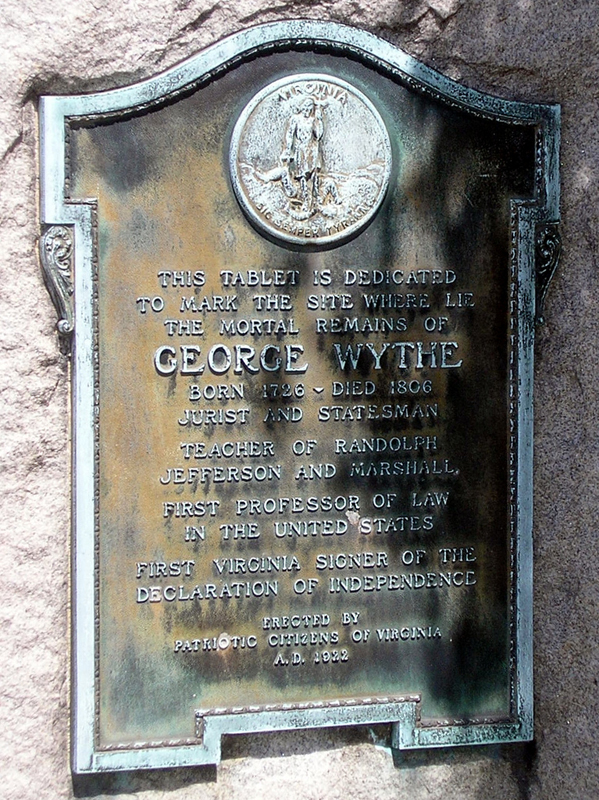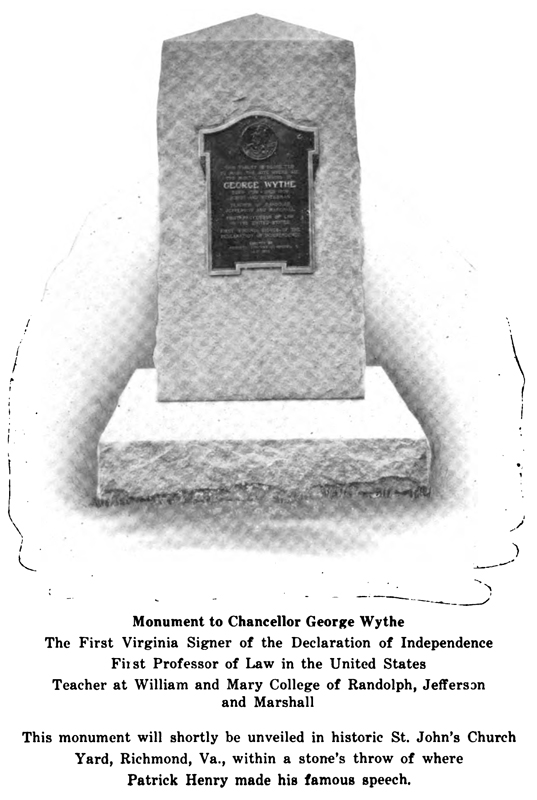Difference between revisions of "Wythe Monument"
(→Sons of the Revolution in State of Virginia) |
m (→Sons of the Revolution in State of Virginia) |
||
| Line 53: | Line 53: | ||
<center>The First Virginia Signer of the Declaration of Independence<br /> | <center>The First Virginia Signer of the Declaration of Independence<br /> | ||
First Professor of Law in the United States<br /> | First Professor of Law in the United States<br /> | ||
| − | Teacher at William and Mary College of [[Edmund Randolph|Randolph]], [[Thomas Jefferson|Jefferson]] | + | Teacher at William and Mary College of [[Edmund Randolph|Randolph]], [[Thomas Jefferson|Jefferson]]<br /> |
and [[John Marshall|Marshall]]<br /> | and [[John Marshall|Marshall]]<br /> | ||
<br /> | <br /> | ||
Revision as of 12:01, 9 July 2013

Monument to mark George Wythe's burial at St. John's Episcopal Church, East Broad Street, Richmond, Virginia.
A smaller plaque at the base of the column was placed sometime after 2004 by Descendants of the Signers of the Declaration of Independence, Inc., to commemorate Wythe as a signer.
An unmarked grave was not unusual at that time, even for such luminaries as signers of the Declaration of Independence. In October of 1899, Mary Mann Page Newton, chairman of the Landmark Committee for the Virginia Association for the Preservation of Antiquities, reported:
Another important work to be done at St. John's is to place some monument on the unmarked grave of Chancellor George Wythe, a signer of the Declaration of Independence, and one of our greatest jurists and purest statesmen. The site of Judge Wythe's home, at the southeast corner of Grace and Fifth streets, now occupied by the residence of Mr. Beverley B. Munford, should also be marked...
Though the glory of the signers of the Declaration of Independence is also Revolutionary, it would doubtless come with perfect propriety within the scope of our own work to mark the places where they sleep. As I have said, George Wythe's grave in St. John's churchyard, has no monument, and it is believed that this is also the case with the last earthly resting-places of Benjamin Harrison, Richard Henry and Francis Lightfoot Lee, and Carter Braxton. [3]

Contents
[hide]Reports of the Virginia State Bar Association
1920
At the 1920 meeting of the Virginia State Bar Association, John B. Minor, Secretary-Treasurer, read a letter from Arthur B. Clarke, President of the Virginia Society of the Sons of the American Revolution, concerning a local effort to erect a suitable monument for Wythe's grave:[4]
Secretary Minor: Mr. President, I have two communications, one of which is a communication from the Virginia Society of the Sons of the American Revolution in, relation to some marker for the grave of George Wythe, which I will read:
- 616 AMERICAN N. B. BLDG., RICHMOND, VA.,
- May 7, 1920.
HON. JOHN B. MINOR, Prest. Bar Association,
- 506 Mutual Building, Richmond, Va.
My dear Mr. Minor:
Wide attention has been called to the neglected graves, in several states, of the Signers of the Declaration of Independence, and a movement is being made to have all such graves marked by stones.
One such, grave is in this city.
Chancellor George Wythe, one of the Signers, one of the most distinguished lawyers of Virginia, a great expounder and great teacher of the law, is buried in old St. John's graveyard on Church Hill, just at the door of the old church. No stone marks the resting place of this man to whom this state owes so much.
Comment on his life and deeds needs not be made in this letter. His accomplishments are known to all members of the Bar Association or should be.
The patriotic societies of this city have appointed committees to take up the matter of marking this grave, and I am sure your Association need only to have its attention called to the matter to approve of the movement, and likewise appoint a committee to co-operate with representatives of other organizations.
Trusting you will bring the subject to the attention of your Association, with desired results, I am
- Yours very truly,
- ARTHUR B. CLARKE,
- Prest. Va. So. S. A. R.
I move that this communication be referred to the Committee on Resolutions, with instructions to report a suitable resolution in accordance with the request.
Seconded and adopted.
The next day, the Bar Association's Committee on Resolutions produced the following:[5]
Be it Resolved, That the Virginia State Bar Association heartily approves the movement inaugurated by the patriotic organizations of the city of Richmond to mark the grave of Ohancellor George Wythe, and directs the President of the Association to appoint a committee to co-operate in the accomplishment of this purpose with the committees of other organizations.
1921
The proceedings of the 1921 meeting of the Virginia Bar Association includes the names of the members appointed to the "Special Committee to Aid in Securing Suitable Marker for Grave of George Wythe": Robert M. Hughes, of Norfolk; Eppa Hunton, Jr., of Richmond; and Eugene C. Massie of Richmond.[6] Hughes had previously served as a member of the committee that placed a memorial tablet dedicated to Wythe in the chapel of the Wren Building at the College of William & Mary, in 1893.
Sons of the Revolution in State of Virginia
In 1922, in the April issue of Sons of the Revolution in State of Virginia Quarterly Magazine, there appeared a photograph of the as-yet-unveiled "Monument to Chancellor George Wythe,"[7] captioned:
First Professor of Law in the United States
Teacher at William and Mary College of Randolph, Jefferson
and Marshall
This monumnet will shortly be unveiled in historic St. John's Church
Yard, Richmond, Va., within a stone's throw of where
Reports of the Virginia State Bar Association
1922
June, 1922. Report of Committee on Library and Legal Literature
Report of Special Committee on Memorial to George Wythe
Proceedings of the Virginia State Conference of the Daughters of the American Revolution
October, 1922. Report of State Historian, Mrs. Robert L. Pierce. Commonwealth Chapter reports:
On Revolutionary Day, May 24th, [Sons of the Revolution in State of Virginia, and the Sons of the American Revolution] and the William Byrd Chapter joined with us in services in old St. John's Church to commemorate the birthday of Patrick Henry and to unveil a tablet to George Wythe, the great Chancellor, and one of the Virginia Signers of the Declaration of Independence. Rev. Hugh Sublett conducted the ceremonies and Governor Trinkle, Dr. Freeman and Mr. George Bryan spoke. Passing out to the churchyard, a wreath was laid on the tablet by the Regent of the Chancellor Wythe Chapter [Mrs. Manly B. Ramos].
References
- Jump up ↑ The Two Parsons; Cupid's Sports; The Dream; and The Jewels of Virginia, (Richmond, Virginia: J.D.K. Sleight, 1884), 429.
- Jump up ↑ Richmond Enquirer, June 10, 1806, 3.
- Jump up ↑ "Report of Landmark Committee," Yearbook of the Virginia Association for the Preservation of Antiquities, 1898 and 1899, 29, 30.
- Jump up ↑ Virginia State Bar Association, Proceedings of the Annual Meeting 32 (1920), 15-16.
- Jump up ↑ Proceedings, 1920, 19.
- Jump up ↑ Virginia State Bar Assocation, Proceedings of the Annual Meeting, 1921, 99.
- Jump up ↑ Sons of the Revolution in State of Virginia Quarterly Magazine (April, 1922) 38.
